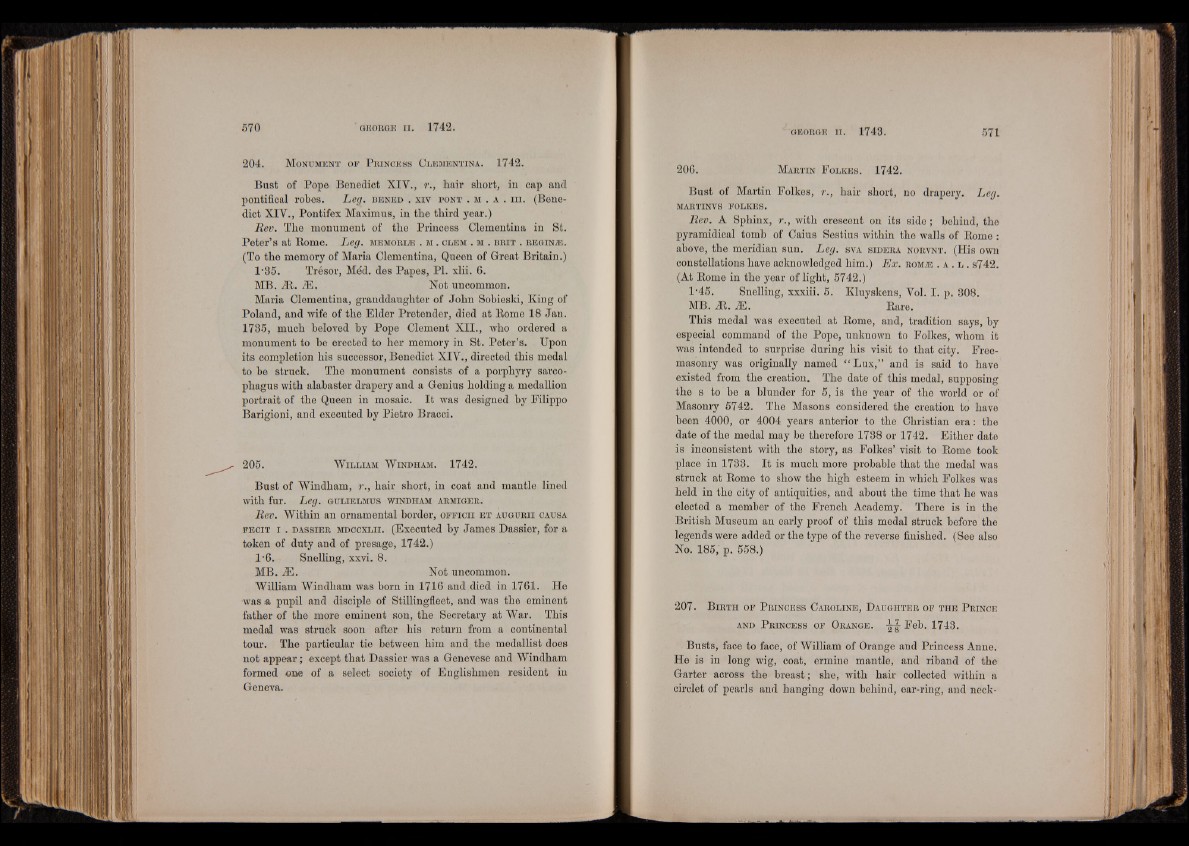
Bust of Pop© Benedict XIV., p., hair short, in cap and
pontifical robes. Leg. b e n e d . xiv po n t . m . a . in. (Benedict
XIV., Pontifex Maximus, in the third year.)
Rev. The monument of the Princess Clementina in St.
Peter’s at Rome. Leg. m em o b iæ . m . o lem . u . b r it . r e g in æ .
(To the memory of Maria Clementina, Queen of Great Britain.)
1-85. Trésor, Méd. des Papes, Pl. xlii. 6.
MB. Æ. Æ. Not uncommon.
Maria Clementina, granddaughter of John Sobieski, King of
Poland, and wife of the Elder Pretender, died at Rome 18 Jan.
1785, much beloved by Pope Clement XII., who ordered a
monument to be erected to her memory in St. Peter’s. Upon
its completion his successor, Benedict XIV., directed this medal
to be struck. The monument consists of a porphyry sarcophagus
with alabaster drapery and a Genius holding a medallion
portrait of the Queen in mosaic. It was designed by Filippo
Barigioni, and executed by Pietro Bracci.
205. W il l ia m W in d h am . 1742.
Bust of Windham, r., hair short, in coat and mantle lined
with fur. Leg. g u l ie lm u s w in d h am a e m ig e e .
Rev. Within an ornamental border, o f f ic i i e t a u g u e i i causa
f e c it i . d a s s ie e MDCCXLii. (Executed by James Dassier, for a
token of duty and of presage, 1742.)
l -6. Snelling, xxvi. 8.
MB. iE. Not uncommon.
William Windham was born in 1716 and died in 1761. He
was a pupil and disciple of Stillingfleet, and was the eminent
father of the more eminent son, the Secretary at War. This
medal was struck soon after his return from a continental
tour. The particular tie between him and the medallist does
not appear; except that Dassier was a Genevese and Windham
formed one of a select society of Englishmen resident in
Geneva.
Bust of Martin Folkes, r., hair short, no drapery. Leg.
MARTINVS FOLKES.
Rev. A Sphinx, r., with crescent on its side; behind, the
pyramidical tomb of Caius Sestius within the walls of Rome :
above, the meridian sun. Leg. s v a s i d e r a n o r v n t . (His own
constellations have acknowledged him.) Ex. rom te . a . l . s742.
(At Rome in the year of light, 5742.)
1'45. Snelling, xxxiii. 5. Kluyskens, Vol. I. p. 808.
MB. .it. M. Rare.
This medal was executed at Rome, and, tradition says, by
especial command of the Pope, unknown to Folkes, whom it
was intended to surprise during his visit to that city. Freemasonry
was originally named “ Lux,” and is said to have
existed from the creation. The date of this medal, supposing
the s to be a blunder for 5, is the year of the world or of
Masonry 5742. The Masons considered the creation to have
been 4000, or 4004 years anterior to the Christian era: the
date of the medal may be therefore 1788 or 1742. Either date
is inconsistent with the story, as Folkes’ visit to Rome took
place in 1788. It is much more probable that the medal was
struck at Rome to show the high esteem in which Folkes was
held in the city of antiquities, and about the time that he was
elected a member of the French Academy. There is in the
British Museum an early proof of this medal struck before the
legends were added or the type of the reverse finished. (See also
No. 185,' p. 558.)
207. B ir t h o f P r in c e s s C a r o l in e , D a u g h t e r o f t h e P r in c e
and P r in c e s s o f Or a n g e . -J-i Feb. 1743.
Busts, face to face, of William of Orange and Princess Anne.
He is in long wig, coat, ermine mantle, and riband of the
Garter across the breast; she, with hair collected within a
circlet of pearls and hanging down behind, ear-ring, and neck